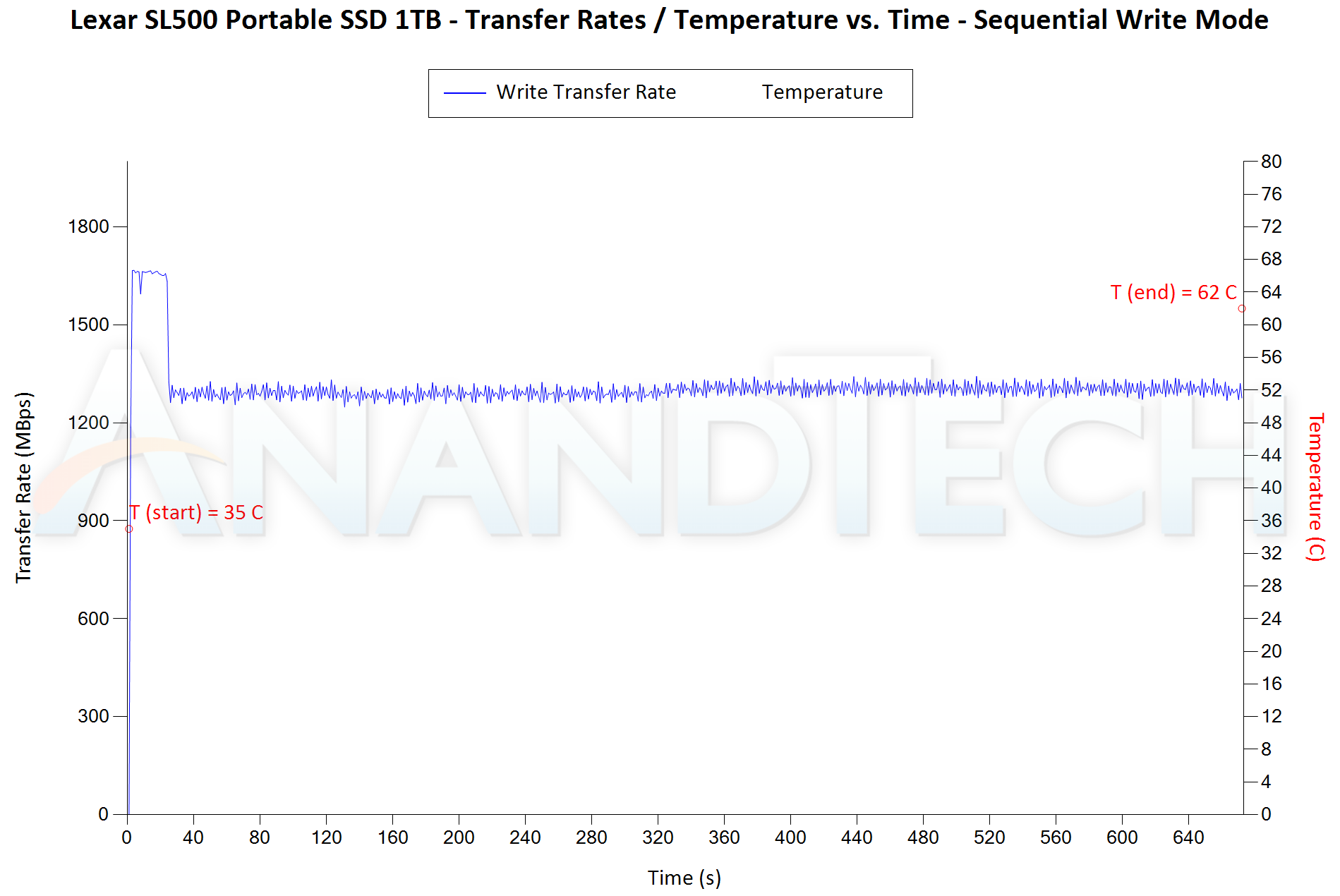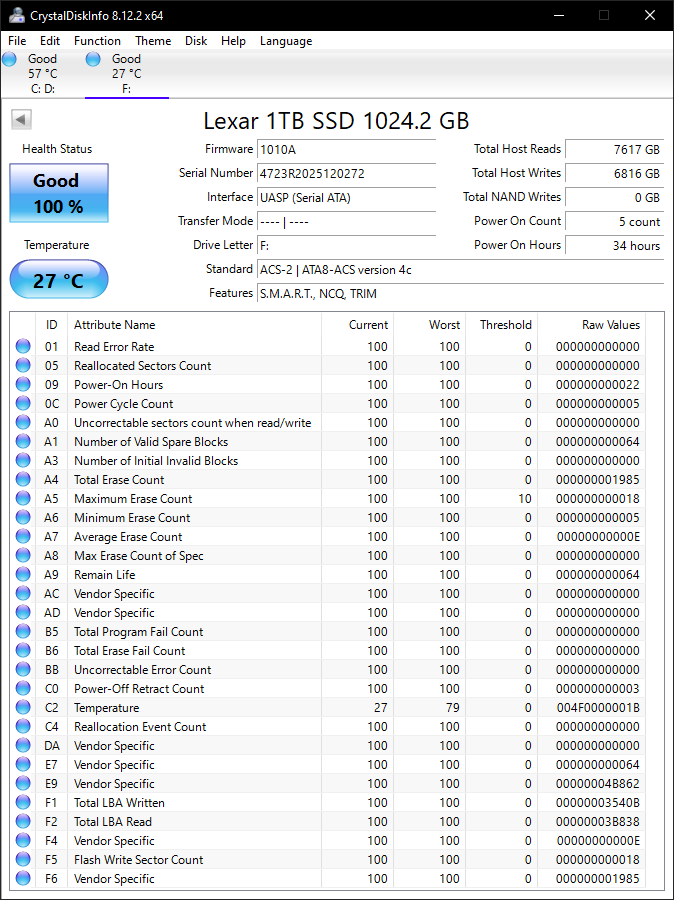Lexar SL500 Portable SSD Review: Silicon Motion SM2320 and YMTC NAND in a Potent Package
by Ganesh T S on April 23, 2024 8:00 AM EST- Posted in
- Storage
- SSDs
- Lexar
- DAS
- Silicon Motion
- YMTC
- Portable SSDs
Miscellaneous Aspects and Concluding Remarks
The performance of the storage bridges / drives in various real-world access traces as well as synthetic workloads was brought out in the preceding sections. We also looked at the performance consistency for these cases. Power users may also be interested in performance consistency under worst-case conditions, as well as drive power consumption. The latter is also important when used with battery powered devices such as notebooks and smartphones. Pricing is also an important aspect. We analyze each of these in detail below.
Worst-Case Performance Consistency
Flash-based storage devices tend to slow down in unpredictable ways when subject to a large number of small-sized random writes. Many benchmarks use that scheme to pre-condition devices prior to the actual testing in order to get a worst-case representative number. Fortunately, such workloads are uncommon for direct-attached storage devices, where workloads are largely sequential in nature. Use of SLC caching as well as firmware caps to prevent overheating may cause drop in write speeds when a flash-based DAS device is subject to sustained sequential writes.
Our Sequential Writes Performance Consistency Test configures the device as a raw physical disk (after deleting configured volumes). A fio workload is set up to write sequential data to the raw drive with a block size of 128K and iodepth of 32 to cover 90% of the drive capacity. The internal temperature is recorded at either end of the workload, while the instantaneous write data rate and cumulative total write data amount are recorded at 1-second intervals.
| Sequential Writes to 90% Capacity - Performance Consistency | |
| TOP: | BOTTOM: |
 |
|
 |
|
The Lexar SL500 1TB offers a peak speed of 1660 MBps for this access pattern and sustains it for around 23s, pointing to a SLC cache of around 38 GB (actual size is probably a bit smaller, given the background folding in the picture). Beyond that, the drive is able to sustain around 1300 MBps all through. The thermal profile seems satisfactory, given that we only tracked the temperature at the beginning and end of the process. These numbers need to be compared against the Crucial X10 Pro's 1600 MBps for 600s, and a drop to 1300 MBps after that.
These numbers track our findings in the previous benchmark section. The Lexar SL500 delivers good performance numbers for workloads as long as the SLC cache is in play. Compared to drives that fall down to USB 3.2 Gen 1 speeds under high stress, the SL500 joins the Crucial X10 Pro as one of the few SM2320-based PSSDs capable of sustaining 1 GBps+ numbers for the full span of the drive.
Power Consumption
Bus-powered devices can configure themselves to operate within the power delivery constraints of the host port. While Thunderbolt ports are guaranteed to supply up to 15W for client devices, USB 2.0 ports are guaranteed to deliver only 2.5W (500mA @ 5V). In this context, it is interesting to have a fine-grained look at the power consumption profile of the various external drives. Using the ChargerLAB KM003C, the bus power consumption of the drives was tracked while processing the CrystalDiskMark workloads (separated by 5s intervals). The graphs below plot the instantaneous bus power consumption against time, while singling out the maximum and minimum power consumption numbers.
| CrystalDiskMark Workloads - Power Consumption | |
| TOP: | BOTTOM: |
 |
|
 |
|
Despite the firmware differences, the power consumption profile is remarkably similar for the Lexar SL500, LaCie Rugged Mini, and the Crucial X10 Pro. The SL500 has slightly lower absolute peak numbers (3W vs. 4W), but the PSSD (like other SM2320 solutions) spends most of the time around the 2W mark. Unlike the LaCie Rugged Mini, the Lexar SL500 does have a true deep sleep mode after idling for around 20 minutes.
Final Words
The Lexar SL500 was introduced at CES 2024 along with a host of other PSSD solutions. This Silicon Motion SM2320 solution differentiates itself from other ones in two aspects - usage of YMTC's 128L 3D TLC and the availability of hardware encryption support. The company seems to be targeting different capacities for different markets. The US market seems to officially only have the 2TB SKU available for $190. The 1TB SKU for $120 ships from the UK. With prices of flash-based storage in a flux, it is not possible to make any comments on the value proposition of the Lexar SL500. However, based on current prices, the Crucial X10 Pro does seem to offer better value for money.
Our only quibbles with the Lexar SL500 are the capping of peak write speeds in the firmware configuration and the absence of a bundled Type-C to Type-A adapter (some vendors supply a cable with an affixed adapter, which is quite welcome when the PSSD is shared across multiple systems). Lexar does have other 2GBps-class PSSDs that reach 2000 MBps write speeds, but the SL500 is limited to 1800 MBps. It is not clear if this is a function of the NAND alone. On the plus side, the power consumption and heat generation are considerably lower compared to other SM2320 PSSDs. This means lesser BOM cost related to thermals.

6.8TB+ writes, and 7.6TB+ reads at the end of our testing routine
The design of the casing is subjectively much better than some of the other SM2320-based PSSDs, and the company is right in stressing the ultra-thin nature of the PSSD in its marketing message. The SLC cache size at 38 GB is acceptable for most consumer / casual user workloads. In any case, the direct-to-TLC writes are also quite good at 1.3 GBps. Overall, this is a win for direct-attached storage workloads. On the general usage front, the random access numbers and the behavior for mixed workloads are a bit off - but it is unfair for consumers to expected native controller solutions to perform as well as bridge-based solutions using DRAM-equipped SSDs in that aspect. Overall, the Lexar SL500 shows the flexibility offered by Silicon Motion's SM2320 solution in good light. Depending on the exact use-case, consumers may find it a good alternative to the Crucial X10 Pro, LaCie Rugged Mini, or the Kingston XS2000.











7 Comments
View All Comments
artifex - Wednesday, April 24, 2024 - link
Are you still working on this article? The link for the Lexar SL500 in the comparison table claims it's going to the Crucial X10, but in fact goes to a LaCie drive.Also, there's tons of HTTP 500 server errors right now :(
Ryan Smith - Thursday, April 25, 2024 - link
Thanks. The review link has been fixed.As for HTTP 500 errors, the server is fine for now. But I appreciate the heads up; I'll keep a look-out for if they return.
Dr_b_ - Thursday, April 25, 2024 - link
YMTC NAND? no, no, no.erotomania - Thursday, April 25, 2024 - link
yep, Yangtze Memory Technologies Corperotomania - Thursday, April 25, 2024 - link
Excellent dropdowns, Ganesh. I don't remember if Expand All has always been an option, but I really appreciate that one. Has Lexar used any YMTC NAND before?Samus - Friday, April 26, 2024 - link
Hey, at least unlike all the other cheap Chinese NAND, it actually holds its rated capacity.pinchies - Tuesday, May 28, 2024 - link
Thank you for reminding us that Lexar is no longer a Micron brand. Now no better than Polaroid. I'm not touching YMTC NAND after being burned once already.